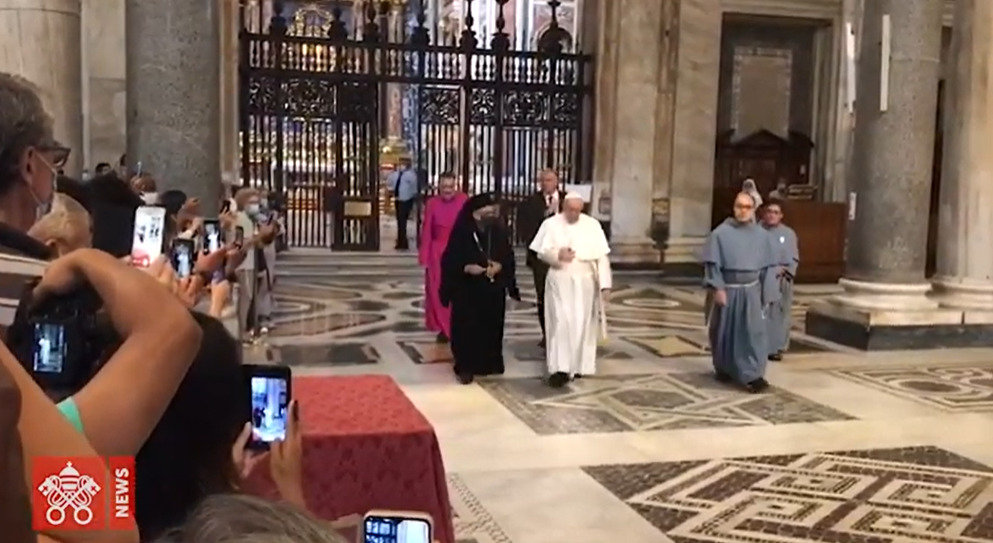Pope Francis made a surprise visit to Saint Mary Major on Wednesday, the feast of the dedication of the Papal Basilica, reported Vatican News.
At the church, the Holy Father knelt for a few moments in prayer in the Borghese Chapel, before the image of Our Lady, Salus Populi Romani (“Salvation of the Roman People”).
The origins of the Basilica are shrouded in legend, as Vatican News recalled.
According to a late tradition, on the night of August 4-5, the Blessed Virgin Mary appeared to Pope Liberius, and to a Roman patrician named John, requesting that they build a church on a spot that would be shown to them.
The first part of August in Rome is notoriously hot and humid. But on the morning of August 5, 358, the people of Rome were greeted with an almost unbelievable sight: a blanket of snow covering a part of the top of the Esquiline Hill, indicating the place where the church should be built.
For centuries, the Church in Rome has celebrated the dedication of the Saint Mary Major, also known as the Liberian Basilica, with special rituals. During the singing of the Gloria at the principle Solemn Mass, a portion of the ceiling is opened, and white jasmine petals are showered on the congregation in commemoration of the miraculous origins of the Basilica.
This year, once again, citizens of Rome and visitors to the City celebrate the miraculous fall of snow that marked the origins of the papal Basilica of Saint Mary Major.
The celebration of the Dedication begins with a meditative Rosary followed by Vespers, celebrated on the days leading up to the feast itself.
This year, the Solemn Pontifical Mass was celebrated on Wednesday morning by Cardinal Stanislaw Ryłko, the Archpriest of the Basilica. After the recitation of the Rosary in the afternoon, Archbishop Piero Marini presided at Vespers, where, at the Magnificat, flower petals once more dropped from the ceiling. The liturgical celebrations conclude with a Solemn Mass offered by Archbishop Francesco Canalini.
Saint Mary Major is one of the four “Papal Basilicas” (the others are the Archbasilica of St John Lateran, St Peter’s Basilica, and the Basilica of St Paul’s Outside-the-Walls). Of the four, it is the only one to preserve its paleo-Christian structure. The Basilicas bell tower is the tallest in Rome, at 75 meters. It contains five bells, one of which – known as “La Sperduta” or “the lost one” – rings every evening at 9 o’clock to call the faithful to prayer.
The magnificent Basilica is comprised of a nave and two side aisles, constructed according to the Vitruvian canon of rhythmic elegance. Saint Mary Major is home to beautiful frescos showing the life of the Blessed Virgin Mary and is justly famous for the series of mosaics recalling events of salvation history: the lives of Abraham, Jacob, Moses, and Joshua, as well as the infancy of Christ.
One can also find in the Basilica the icon of Mary, Salus Populi Romani (“Salvation of the Roman People”), which popular piety has always held in the highest esteem.
Pope Francis, too, is particularly devoted to the Blessed Mother under this title and visited the Basilica the day after his election to the pontificate in 2013 to offer prayers in the chapel that houses the image. In the succeeding years, the Holy Father has repeated this visit before and after his Apostolic Journeys, to offer prayers and thanksgiving to our Blessed Mother.
A pious legend holds that the Icon of the Salus Populi Romani was painted by St Luke the Evangelist. It is normally kept in the Borghese Chapel in the Basilica, although it is occasionally moved for special occasions.
Most recently, the icon was brought to St Peter’s Basilica for Pope Francis’ extraordinary Urbi et Orbi blessing to pray for an end to the coronavirus pandemic.



